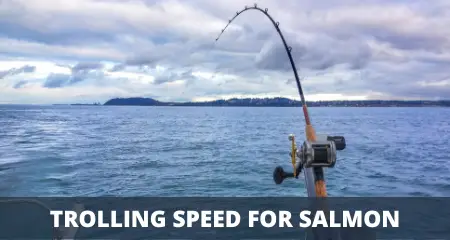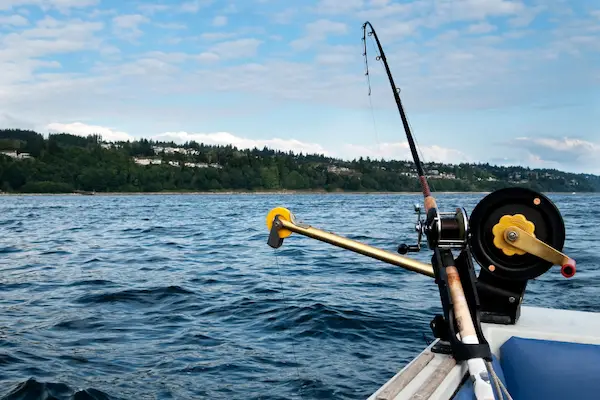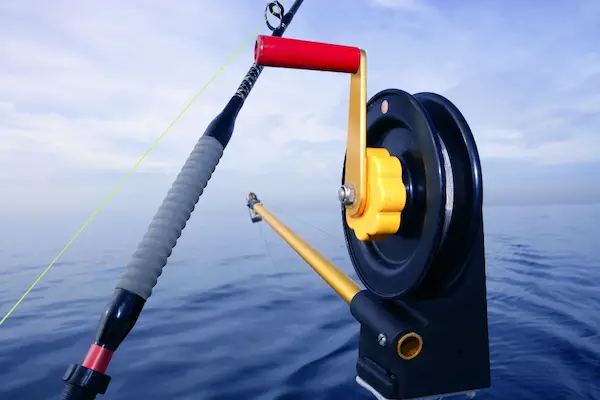Best Salmon Trolling Speed (Here’s What You Need To Know)
UPDATED 03 NOVEMBER 2023
by Robert Ceran
Trolling is one of the most effective ways to catch salmon, consistently producing more fish than any other salmon fishing technique.
However, trolling for salmon is also more challenging than other fishing methods, and requires a lot more know-how.
When targeting salmon, one of the key factors that can make the difference between success and failure is your trolling speed.

In this article we’ll cover the ideal trolling speed for different types of salmon, as well as for different types of trolling setup.
What is the best speed for trolling salmon?
The ideal salmon trolling speed depends on the type of salmon you’re targeting, as well as your trolling setup:
- King salmon: 2.0 to 3.0 mph
- Coho salmon: 3.0 to 5.5 mph
- Pink salmon: 2.0 to 3.0 mph
- Landlocked salmon: 1.5 to 2.5 mph
- Ocean salmon: 2.5 to 3.5 mph
- Salmon trolling with downriggers: 1.5 to 3.5 mph
- Salmon trolling with lead core line: 1.0 to 2.0 mph
- Salmon trolling with dipsy divers: 2.5 to 3.0 mph
In addition to these differences, you also need to factor in the strength of the current and the wind, plus the preferences of the salmon on any given day.
So the best strategy is to start with the trolling speeds given above, and then experiment with varying them until you find what works best for you on any given day.
Ideal trolling speed for different types of salmon
Now let’s take a closer look at the different kinds of salmon that are most often targeted with trolling tactics.
While you can potentially catch all salmon species with trolling, the most commonly targeted salmon species with this fishing tactic are king (chinook) and coho salmon.
King salmon
The ideal trolling speed for king (chinook) salmon is 2.0 to 3.0 miles per hour. However, the exact trolling speed is not as critical for king salmon as it is for other types of salmon.
You can be sure that a king salmon can swim fast enough to catch up with your lure even at higher trolling speeds, so feel free to test higher speeds similar to what you would use for coho.
The key thing to look for when adjusting your trolling speed for king salmon is that you’re getting the right amount of action from your salmon trolling setup, including your flasher as well as the lure or cut bait rig (more on that below).
Coho salmon
The best trolling speed for coho salmon is 3.0 to 5.5 miles per hour.
This speed is faster than for most other salmon species, and reflects the fact that coho are strong swimmers that like to feed aggressively.
In addition, most coho are caught in shallow water between 6 to 50 feet depth.
So if you’re specifically targeting coho salmon, be prepared to troll faster and more shallow than for other salmon species.
If you’re looking for the best destinations to catch salmon, check out our article on where can you catch salmon in the USA?
Pink salmon
The ideal trolling speed for pink salmon is 2.0 to 3.0 miles per hour, though you may find that slower or faster speeds can work better in some cases.

So when trolling for pink salmon, it’s essential to vary your trolling speed until you start getting bites.
Similar to coho salmon, you don’t need to troll very deep for pink salmon. Depths between 10 and 60 feet are ideal, which you can achieve without a downrigger.
Landlocked salmon
The ideal trolling speed for landlocked salmon is 1.0 to 2.5 miles per hour, depending on the current and the lure that you’re using.
The term landlocked salmon is most often used for either Atlantic or Kokanee salmon that are stocked in large lakes that have no connection to the ocean.
So, while salmon normally migrate to the ocean to complete their life cycle, landlocked salmon spend their whole life in freshwater.
Landlocked Atlantic salmon are stocked in many lakes of the northeastern US, and are most common in New England. They are smaller than their seagoing relatives, and rarely reach sizes over 10 pounds.
Ocean salmon
The ideal trolling speed for ocean salmon is 2.5 to 3.5 miles per hour. This is similar to the salmon trolling speed used in the great lakes, including Lake Ontario, and Lake Michigan.
But once again, it’s important to adjust your speed depending on the current, as well as your flasher and lure setup.
Vary your trolling speed
If you’re trolling in a straight line and not getting any bites from salmon, a great option is to change things up by varying your trolling speed, or by trolling in S curves.
Every time you change direction, your trolling lure slows down, and then speeds up again.
I’ve found that speeding up or slowing down for a few moments regularly triggers bites.
This probably happens when salmon follow your lure but without eating it. When they notice that the lure changes speed, this can be enough to trigger a salmon bite.
How to measure your trolling speed
In general, the best way to know how fast you’re trolling is to use GPS and measure your speed over ground. However, you do need to keep in mind that the current also factors into this.
For example, if you’re trolling straight into a strong current, this will increase your trolling speed without affecting speed over ground. In that case you should slow down a little, but speed up if you’re trolling at a ninety degree angle to the current, or with the current.
What speed for trolling salmon should you use with downriggers?
The ideal speed to use when trolling for salmon with downriggers is 1.5 to 3.5 miles per hour. A great way to check if you’re trolling at the right speed is to look at the line angle of the downrigger line.

If you’re using a 15 lb cannon ball weight with your downrigger, adjust your speed until you get a 45 degree angle between the arm of the downrigger and the line.
If the line is hanging straight down, that means you’re trolling too slow, and if the line angle is more than 45 degrees, that means you’re too fast.
What salmon trolling speed should you use with dipsy divers?
The best speed to use when trolling for salmon with dipsy divers is 2.5 to 3.0 miles per hour. At that speed you can reach dive depths of 20, 30, 50, or 100 feet, depending on the size dipsy diver that you use.
Using a dipsy diver setup is a great alternative to using a downrigger, while still trolling deep enough to catch salmon in 100 feet deep water or shallower. If you need to reach greater depths than 100 feet, then a downrigger is your best bet.
What salmon trolling speed should you use with lead core line?
The best trolling speed to use with lead core line is 1.0 to 2.5 miles per hour. Lead core line is best suited for slow trolling speeds. Unlike a dipsy diver, lead core line runs deeper the slower you troll.
This is because when you troll faster, there is more resistance on the lead core line, which pushes it up in the water. That means you’re limited in the top speeds at which you can troll with lead core.
However, if you find that salmon in your fishery respond well to slow trolling speeds, then lead core line is a great option. Lead core line is often used when trolling for salmon in Lake Ontario, New York.
How does lure choice affect salmon trolling speed?
When trolling with flashers and artificial lures for salmon, it’s essential that your lure has the right amount of action in the water.
For example, a flasher needs to have a solid spinning motion in the water in order to work. And if your trolling speed is too slow, it will just wobble lethargically, which doesn’t attract salmon.
The same goes for trolling spoons, crankbaits, spinners, and plug cut herring. They should all have a tight spin or vibration in the water in order to trigger salmon bites.
The best way to check if your trolling speed is correct for your trolling rig and lure, is to take your salmon trolling rod, and lower the rig slowly into the water while your boat is moving at the chosen trolling speed.
If you see that the flasher and lure action looks good, then go ahead and release line from your line counter reel until your trolling rig reaches the right depth. If not, adjust your speed until you get the perfect action on your setup.
